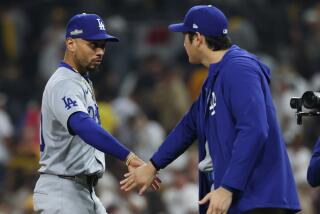Is National Pastime Past Its Prime?
- Share via
The last-minute accord between major league baseball’s owners and players may have saved the season, but can it save the sport?
By many indications, big-league baseball is in decline. Attendance at ballparks is down. Television viewership of the World Series has plummeted. The fan base is aging. Fewer kids play it. Once America’s undisputed summer king, baseball now competes against football, basketball, Game Boys, extreme sports, the Internet and satellite TV services with hundreds of channels.
The sport’s checkered labor history, not its only woe, has served to further alienate fans, evidenced by those in Anaheim on Thursday who pelted players with trash and shouted, “No strike!”
“The fact is that by devoting so much energy to war with the union over the years ... baseball doesn’t do all the things it has to do to develop the game,” said Fay T. Vincent, baseball commissioner from 1989 to 1992. “It can’t spend time and money on youth baseball. It can’t spend on marketing.... I think the cost of bad labor relations in baseball has been monumental.”
Anxiety about the future of the sport all but hovered over the negotiating table and may have motivated both sides to avert a strike, said William B. Gould, a Stanford University professor who is working on a book about how baseball has changed.
The fear was that a strike would have led “to a smaller number of kids actually participating in the game,” said Gould, who as former chairman of the National Labor Relations Board was involved in the 1994-1995 strike and sided with the players. “There are other sports and forms of entertainment occupying people’s attention.”
League officials said Friday that the labor agreement would help attract more fans. Bringing competitive parity to the game, they said, ultimately would give more franchises a shot at the World Series.
“The greater anticipation in the stands and at home is one of your best marketing tools,” said Vince Wladika, a spokesman for major league baseball.
To gain more exposure, the league has more than doubled its sponsorships to $170 million in recent years and launched its own Web site in 2001. Wladika and others say the sport’s ratings are no cause for alarm, since there has been a similar slide in numbers for all network programming because of the proliferation of cable and satellite channels.
“Is the sport on the decline? No,” said Douglas Noverr, chairman of the American thought and language department at Michigan State University, who has researched and written about the game. “I think baseball has an underlying cultural mythology that is very resilient.... No sport generates a fascination with numbers the way baseball does.”
But others say the falling interest in the game is far more serious. The sport must find a way to do what the National Basketball Assn. and National Football League do so well: remain relevant to a fickle audience with plenty of choices.
The NBA has aggressively courted young fans and a hip image. The NFL, also aware of an aging fan base, is tackling the problem head-on: On Thursday, the league will kick off its 2002 season with a free street party for 100,000 people in Times Square in New York featuring Bon Jovi, Enrique Iglesias, Eve and Alicia Keyes.
By some accounts, baseball is still paying for its last player strike, a marathon affair that canceled the 1994 World Series. Attendance dropped from a game average of 31,256 in 1994 and has yet to rebound fully; it is now 29,813, league figures show.
Television viewership of the World Series and the All-Star game, baseball’s signature events, has dropped dramatically. An average 44 million people tuned in to see the Philadelphia Phillies beat the Kansas City Royals in 1980, compared with 29.6 million viewers who watched the Arizona Diamondbacks upset the New York Yankees last year in one of the most exciting championships ever.
This year’s All-Star game pulled in 14.7 million viewers, the fewest ever, Nielsen Media Research reported.
More ominous are figures for youth participation. There was a 10% decrease in the number of children ages 7 to 17 who played baseball between 1991 and 2001, a survey by the National Sporting Goods Assn. found. That compares with a 238% increase for those who go snowboarding and 163% increase for children who in-line skate--numbers that underscore the growing competition baseball faces for replacement fans.
Meanwhile, the sport struggles with demographics. The average television viewer is 51 years old, compared with 45 for football and 40 for basketball, say executives at the Fox network, which carries national baseball broadcasts. Advertisers and sponsors generally spend more money on programming that reaches a younger audience.
The game’s drooping fortunes have even dragged down the multimillion-dollar trading card market. Baseball accounts for 60% of all sports and entertainment trading cards sales--and those tumbled from $800 million before the 1994 strike to $350 million this year, said Scott Kelnhofer, editor of Card Trade, the journal of the sports collectible industry.
“There’s an old saying: ‘As baseball goes, so does our industry,’ ” Kelnhofer said.
Others say there’s no need to panic and call some of those figures deceiving.
Cal State Bakersfield economics professor David Berri says baseball attendance has more than rebounded after the bitter 1994 strike.
He says his research shows that the figures haven’t reached pre-strike levels because the players walked out during a time of artificially high head counts caused by two teams playing in large football stadiums.
“To the average person going to the game, this is simply entertainment,” Berri said. “And when the game is taken away, they’ll find other ways to entertain themselves until the game comes back.”
His observation was echoed by Jeffrey S. Brand, dean of the University of San Francisco law school and a confirmed baseball nut.
Brand said he felt “disgusted” with both sides in the labor talks, especially after realizing that the salary of Texas Rangers shortstop Alex Rodriguez, the sport’s highest-paid player, is about 80% of the annual gross national product of Cambodia.
But even his moral outrage won’t keep him from the sport.
“I think it hearkens back to what people want, whether it’s nostalgia or a slower pace or just the skill of hitting a ball that has 105 red stitches and is traveling at 95 miles an hour.... That appeal, thank God, can’t be killed by fights over luxury taxes and revenue sharing.”
It can, however, be dimmed by time and the sport’s apparent inability to react quickly enough to social circumstances, others say.
The signs already are appearing. Empty ball fields dot the landscape of a nation that has cocooned with its computers, moved on to the skateboard parks and gravitated to athletic pursuits other than a game grounded in the agrarian past, said Robert Thompson, professor of media and popular culture at Syracuse University.
“You can really begin to see the change in the relationship between baseball and the American heart by driving around in America, by seeing baseball diamonds without kids playing baseball on them,” Thompson said. “Soccer balls, yes. Basketballs, absolutely. Footballs, yes.
“I don’t think averting the strike is going to put 12-year-olds on the vacant lots and baseball fields like they were 40 years ago,” he said. “We’re going to have to see if baseball can survive.... Shot-putting was really big in ancient Greece. It’s not so big anymore.”
*
Times staff writers Karen Kaplan and Meg James contributed to this report.
More to Read
Go beyond the scoreboard
Get the latest on L.A.'s teams in the daily Sports Report newsletter.
You may occasionally receive promotional content from the Los Angeles Times.










